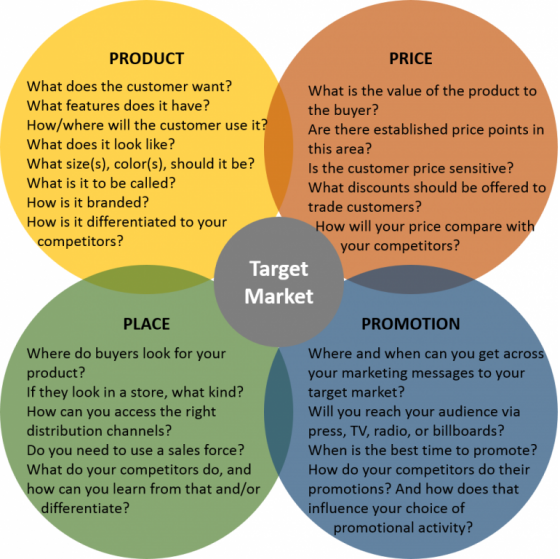A company’s marketing mix most commonly consists of the “4Ps of marketing”: product, place, price and promotion. They are intricately and sensitively related to each other and have to be configured in a consistent manner. The product offering refers to the values customers can obtain by acquiring the company’s product. The place then describes the channels through which this acquisition as well as preceding and subsequent steps of the transaction can take place. The product’s price by which the customers can acquire the product has to be set in relation to the company’s position in the market, its competitors and cost structure. Dynamics in the pricing have to be regarded as well. The promotion of the products comprises advertising, sales promotion, public relations and direct marketing as communication channels with (potential) customers.
Based upon its understanding of the market and customers (see Market Analysis), a company develops its marketing mix of product, place, price, and promotion. These elements are also referred to as the “4Ps of marketing”. They are intricately and sensitively related to each other, i.e. they have to reinforce each other to enhance the experience for the customer. When a change is proposed to be made in one of the elements, its consistency with the other elements has to be checked again. Contradicting elements make the marketing mix less effective in serving customers. Managers must manage these 4Ps in a way that they satisfy customer needs better than the competition.
The product offering is not limited to the physical good itself, but rather refers to the total package of benefits obtained by the customer when consuming the good or service. For marketing strategy development purposes, the product has to be considered from the point of view of value delivered to the customer. This value can exist in quantitative (e.g. price, speed, efficiency) or qualitative (e.g. design, experience, status) terms (OSTERWALDER and PIGNEUR 2010).
The following terms and attributes are commonly used to describe a product mix:
- Product item: a specific version of a product that is designated as a distinct offering from a company.
- Product line: a group of related (e.g. by serving the same customer segment) product items (INVESTOPEDIA NO YEAR).
- Length: the total number of items offered by the company.
- Width: the total number of product lines offered by the company.
- Depth: the number of varieties within one product line.
- Consistency: the relation between items, i.e. how close the product items are to each other.
Place is again not to be understood in the narrow physical sense of the word. In the marketing mix, place describes the marketing channels, i.e. the set of mechanisms or networks via which a company reaches customers with its products. This comprises the physical as well as virtual distribution of information, the product itself and after sales services.
Pricing is a complex activity within the design of the marketing mix. The price of a good or service is subject to several considerations. If the company is entering a market, the price can be used as an entry point to attract customers. While low pricing might be tempting in the beginning, they can backfire when customers are not willing to accept price increases at a later stage. In addition, prices are set in relation to the competitors’ prices. These prices might be changing over time. A company has to have a concept in place on how prices should be adapted to varying circumstances and opportunities. Another consideration lies on the relation of prices to the company’s cost structure, which is essential for its profitability.
Subscribe here to the new Sanitation and Water Entrepreneurship Pact (SWEP) newsletter. SWEP is a network of organizations joining hands to help entrepreneurs design and develop lasting water and sanitation businesses.
The promotion of a company’s products consists of the following four elements:
- Advertisement: It provides the potential customers a reason to buy the product. It creates awareness for the product, describes the features and benefits of the product, creates an image of the product and directs potential customers to the point of sale, i.e. the place.
- Sales promotion: It provides incentives to buy the product by stimulating decision making via for example discounts or free initial services such as feasibility studies.
- Public relations: In order to build additional awareness, credibility and understanding of the company, public relations can be used as a complementary communication channel. It assists to position the company within the market and to influence specific target groups by means like sponsorships, events and publications.
- Direct marketing: When communication efforts are targeted at the individual (potential) customer, direct marketing can be used. Here, a direct contact between the company and the (potential) customer is established via face-to-face or written communication, using both traditional channels and the internet.

Key questions for designing a marketing mix. Source: Own illustration, adapted from SMARTDRAW (NO YEAR).
As markets in general become more globalized, digitalised, customer-focused and service-based, the 4Ps have evolved as well and several newer concepts exist. One popular concept complemented the four elements of a marketing mix by three more “Ps”, making up a total of 7Ps (CIM 2009):
- People: As customers often come in contact with a company’s employees, these people become an important part of the marketing mix.
- Process: The way the interaction with customers is organized, is essential. This is especially relevant in regard to time, e.g. waiting times or time for information search.
- Physical evidence: Especially important to service providers is to make intangible products tangible to the customers. Office facilities are a good example of how a service company can provide a physical evidence for its services.
Social marketing is the use of commercial marketing techniques to promote the adoption of behaviour that will improve the health or well-being of the target audience or of society as a whole. For more information about social marketing go to this invalid link.
Marketing and the 7Ps
Business Model Generation
Why the 4C’s Marketing Model is Good for Business
This homepage presents a different way of approaching marketing.
CHIANIS, A. (n.y): Why the 4C’s Marketing Model is Good for Business. In: Business Bee: URL [Accessed: 11.12.2015]Marketing and the 7Ps
Introductory Guide to Sanitation Marketing
This Guideline, developed by the WSP, is a toolkit for practitioners to define sanitation marketing and key components of a sanitation marketing initiative and provide an overall framework for scaling up rural sanitation programs using a marketing approach.
DEVINE, J. ; KULLMANN, C. (2011): Introductory Guide to Sanitation Marketing. In: Water and Sanitation Program: Toolkit: URL [Accessed: 11.12.2015]Sanitation Marketing: A handbook for Sanitation Managers and Private Sector Players
This handbook outlines key facts about sanitation marketing, a step-by-step approach to development and implementation of a sanitation marketing project and also suggested key references for further reading for a wide range of audiences but more specifically, policy makers, program managers, business entrepreneurs in sanitation, financial institutions and behavioral change communication specialists.
NABEMBEZI, D. NABUNYA, H. (n.y): Sanitation Marketing: A handbook for Sanitation Managers and Private Sector Players. Ministry of Health Uganda and PLAN Uganda URL [Accessed: 11.12.2015]Start your Sanitation Business
The entrepreneurship guide “Start your Sanitation Business” is a training guide for masons, manual and mechanical emptiers of latrines. The guide aims to present to the reader the basic steps for him/her to create a small-scale business in the sanitation sector in four steps. The guide can be used for self-study as it is an interactive document with theory and around 30 related exercises and answers. WASTE offers also a 3-day training based on the guide. It has to be noted that the guide is still in a draft version, as it is continuously updated.
AGATHOU, N. (2011): Start your Sanitation Business. For Masons, Manual and Mechanical Emptiers of Latrines. Gouda: WASTE URL [Accessed: 24.04.2012]The Marketing Mix – the 4Cs
The tool asks you to consider a number of statements based on the 4Cs and answer true or false. It is an exercise you can do on your own or with a group and should take 20 to 30 minutes. It is suitable for businesses of all scales and sectors.
CREATIVE & CULTURAL SKILLS (n.y): The Marketing Mix – the 4Cs. In: Business Survival Toolkit: URL [Accessed: 11.12.2015]Marketing Teacher
Free online learning material on marketing with examples on marketing mixes, marketing strategies etc.
MARKETINGTEACHER.COM (n.y): Marketing Teacher. MARKETINGTEACHER.COM URL [Accessed: 11.12.2015]http://www.marketing91.com
This webpage shows sample marketing mixes from famous brands, such as Apple, Samsung and McDonald’s.
http://www.entrepreneurial-insights.com
This wegpage presents key basic information regarding to marketing, including a simple step by step process on how to develop a marketing mix.
http://businesscasestudies.co.uk
This webpage offers an extensive revision pages, download free case studies from real world companies and associated lesson materials and worksheets for teachers and students.



